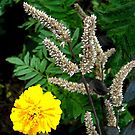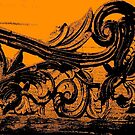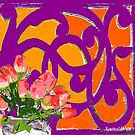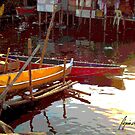
"Look, ma! He can draw!"
I am certain I was barely six years old when I heard my Kuya Boy blurted out those words to my mom. With a blue ballpen, I went on to finish drawing little Audrey from a comic book on sheets of pad paper with gusto. I just smiled back at my mom and brother who were then so delighted at what I was doing on the pasimano.
Since then, people have raved about my so-called talent and it was the only thing I really love doing when I was in grade school. My projects in arts were always displayed on classroom bulletin boards. And I did make a name for being a little artist.
For the child in me who always finds refuge in a lot of playing and doodling, it spelled happiness. It was all I have; my only world!
Everyone thought I'd be an artist that I'd set my mind on taking fine arts in college. But most parents believe there's no money in painting; mine is no exception.
My world crumbled. It was the end. I could not be a painter! It was so revolting
that I had to kick my poor sheepdog named Shaolin to release the angst.
I just could not recall how I recovered or maybe I have just given up. I pursued my second option -becoming a writer and an educator much to the displeasure of many of my elders. Somehow, I did become a writer and I thought that was it. But the artist in me kept creeping into my system.
At a time I thought I have abandoned dreaming of becoming an artist, I met Simon Saulog.
It was in 1983 and I was president of our town's Painters' Club. We held exhibit dubbed Lapis, Papel atbp. with former Imus Mayor Jose Jamir as guest.
Mayor Jamir's attendance was with good tidings. He invited us to represent the young generation of artists of Imus in an exhibit that will honor a master painter, Simon Saulog.
A master painter from Imus?
We were all intrigued for that was the first time we heard his name. All we know about the Saulogs is a bus line plying the Cavite-Lawton route in Manila. So Mayor Jamir arranged a meeting so we could meet Saulog in the municipal hall.
And so we came and there was the maestro in his thick glasses; very quiet. He burst into a boyish smile when he saw us enter the mayor's office. It was like he could smell artists from afar. In a matter of minutes, we felt like we have known him for ages.
That meeting was to be a turning point not only of my life but .my friends as well. He was so proud of what we were doing that he volunteered to coach us for free. And later, he became our adviser when we moved on to be a socio-civic organization called the Malayang Sining.
For a year, we held sessions with the maestro at the municipal hall every Sunday.Being with Saulog was like a long educational journey, not a trip. The successive visits to Mabini and Ermita in Manila, especially the old Palermo gallery along UN Avenue were exhilarating.
His experiences during the pre-war Philippine art especially the "battle royale" between modernists and conventionalists, the Huks and the NPAs, his contemporaries at the UP College of Fine Arts, politics of that time, were good enough for screenplays. We were caught in a time warp. Listening to him was leafing through the pages of a journal turning yellow.
It was then that we realize the magnanimity of our dear maestro. It was then that we realized how a man like him could fade into obscurity.
I personally could not forget how embarrassed he was when we went to the National Museum to show us one of his earliest works; only to learn that it was nowhere to be found in the museum. We left the museum with the maestro's deafening silence.
I could not forget how his eyes were when he learned that there was a move to make Legaspi, one of his contemporaries, national artist; when he came across published articles praising Anita Magsaysay-Ho. He could not forget her.
And there were so many questions in my young mind then. I couldn't believe that he almost lived the life of a pauper. But the answer came from him. He believed that money is "bulaklak lang ng buhay". He did not use his passion to make money. So my parents were right, after all, I thought. But I was mesmerized by his canvasses. They all have the touch of a master. They were gems. To my young eyes, they were bedazzling that I went on to dream.
Something must be done (not about my dream), we thought. He was after all the acclaimed Filipino painter of the Madonnas of the 1950s! And the Malayang Sining saw my pen as an instrument. I was tasked to write about the life of our maestro. The journey into his personal life began in 1986 and it has not ceased, though our maestro bade this world farewell in 1995. He may not have seen the fruits of our labor as young artists then, but we have always had the seeds he planted in our hearts.
Truly, God has a reason for everything. I realized why I felt so helpless in helping him during those times. I have always thought of giving up on a lot of things. And one of them is Saulog's biography. Then, I could not fathom why. It was not the right season.God was to create more time and people to lend me a hand through my colleagues at the Institutional Communication Office of De La Salle University-Dasmarinas (DLSU-D), Philippines.
DLSU-D is celebrating its silver jubilee and part of the celebration is feting a prominent Caviteno in the person of Simon Saulog. A compact disc on the life and works of the maestro, authored by myself, was launched in a three-week exhibit opened by the Hon. Helena Benitez and held at the Museo De La Salle.
The event was a product of collaborative work for a deserving man like our maestro. It is about the man himself; his humanity; his greatness.
I may not have lived a colorful life like him but Saulog remains an inspiration to me.
Now, I can almost hear my older brother saying: "Look, ma! My brother is an artist!" .
-Published, Philippine Panorama
February 9, 2003
















No comments:
Post a Comment